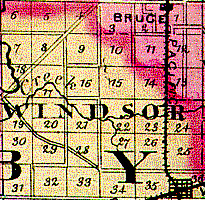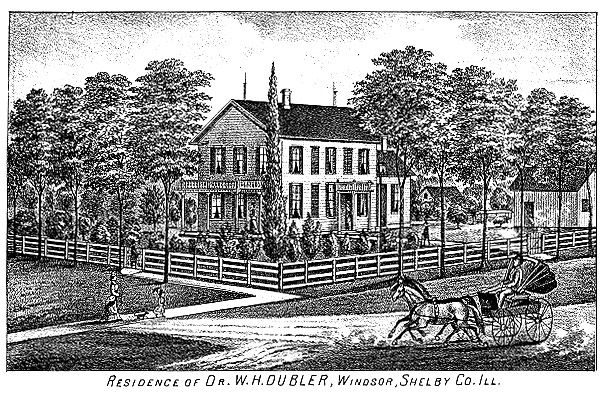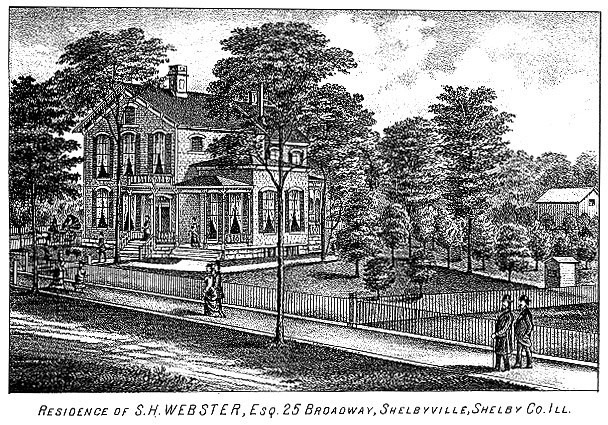WINDSOR TOWNSHIP (SHELBY COUNTY)
WINDSOR is situated on the east side of Shelby county, and contains thirty sections of land; it is bounded on the north by Moultrie county, south by Richland township, west by Okaw township, and on the east by Ash Grove township and Moultrie county
. The Okaw, or Kaskaskia river flows through two sections on the west side of the township; Sand creek drains the centre of the township from east to west; Lick creek and Carr creek are two small streams in the south part, tributaries of Sand creek. Wolf
creek is a small stream in the north part, and flows into the Okaw river. Originally the west part of the township was heavily timbered along the Okaw; the land is considerably broken. In the east and south part the land is very rich, and here were made s
ome of the early settlements of the county. The first was Elias Carr and Isaac Corbin; they located their cabin on a prong of Sand creek, now called Carr's creek, in 1826. The cabin stood a short distance from where the Methodist Church now is, on section
twenty-eight.
In the early spring of 1827, Benjamin Moberly built a cabin in the edge of the timber on the south side of Sand creek, on section twenty-six. He was born in Madison county, Kentucky, in 1799. In 1812 his father emigrated to what is now Franklin county, th
is state, where he lived a number of years in a fort, as the Indians
Page 236
were very troublesome at that time. Mr. B. Moberly now lives in Windsor, and is a hale and hearty old gentleman, full of life and energy, and delights in talking of the olden time. The third house was put up by Isaac Sherley, a short distance east of wher
e Moberly settled, now known as the Joseph Walker place. Moberly and Sherley were brothers-in-law, and came here together. They brought with them a load of salt, and part of a barrel of whiskey, for which they found a ready sale, to the settlers on Richla
nd and Jordan creeks. Sherley did not remain long; he was of a roving disposition. He died in Kansas some years ago.
Joseph Baker settled the John Walden place in 1827. Daniel Turrentine built a cabin at the head of the north prong of Sand creek, on section twenty-three, in 1828, where he resided until his death. His aged wife still survives him, and lives on the old pl
ace.
Daniel Davis was one among the first settlers at the head of Sand creek; he was a blacksmith, although not an expert in his trade. He could mend a chain or clevis, and at that time was considered a very useful citizen. He sometimes preached to the early s
ettlers.
Benjamin Bruce located west of the Sulphur Spring, on section twenty-eight, in 1829, where he lived a short time, and afterwards settled the William Hartsell place, on section twenty-two, where he resided until his death in 1861. He was twice married, and
raised a family of twelve children.
Col. Peter Warren, a native of Virginia, from Tennessee, here settled on section thirty-two in 1830, now the Samuel Thompson place. He raised a family of fifteen children; three are now living. Elder P. P. Warren, who lives on section twenty-eight, Joseph
Warren now living in Ash Grove township, and Mrs. Ann Robinson of Windsor township. Col. Warren was a militia colonel in Tennessee before he came to Illinois, and was a militia general in this State; was Captain of a company in the Black Hawk war, and re
presented this district in the State Senate for a number of years. He resided on the place he improved until his death in 1858. David Robinson settled on Carr's creek as early as 1830. In 1829 Alfred Wallis located on section twenty-seven; two years later
his father, Jacob Wallis, located on the same section. They were natives of Kentucky; came to Southern Illinois as early as 1820.
Daniel Miner came to the township in 1838; his wife, who was a Miss Ledbetter, came to the county in 1824, with her parents.
Daniel Tull, a native of Tennessee, settled on the south side of the north fork Sand creek, section twenty-three, in 1829. He had two married children, who accompanied him to this county: Elizabeth, wife of B. Bruce, and J. B. Tull, his eldest son, who se
ttled at the head of Sand creek, between the forks. J. B. Tull only remained here about two years, when he returned to Tennessee. After eight years he came back to this township, and settled on sec. nineteen, where he resided until his death. His widow ye
t lives on the old place; they have three sons living here.
Benjamin Weeks was one of the early settlers here. He lived on the Joseph Walker place as early as 1832.
Nathan Gaddis, now living on Wolf creek, has lived in the country since 1839.
James Richardson, a native of Indiana, settled on section eight, in 1839; he has two sons still living here, George and John.
Judge William Williamson, a native of North Carolina, came to the country about 1825. In 1830 he bought a "squatter's" improvement of William Weger, near the head of Carr's creek. Williamson was elected first sheriff of this county, and filled the office
two terms; was first lieutenant in Captain Price's company in the Black Hawk war; was first county surveyor; he filled the office of county judge for some time; afterwards represented this county in both houses of the State Assembly. He died in this towns
hip on the place he improved.
W. F. Hilsabeck, now living on section sixteen, has lived in the county since 1834. His father, Frederick Hilsabeck, was a native of North Carolina; he came to Hillsboro, Montgomery county, Illinois, in 1830, and to Shelbyville four years later, and follo
wed blacksmithing in Shelbyville many years; he died three miles north of Shelbyville in 1856. Five of his children now live in Shelby county, two in Missouri, and one in Kentucky. W. F. Hilsabeck settled where he now lives in 1845; the place was first se
ttled by Jonathan Wyman.
The Waldens are early settlers here; they first settled in Richland township. (See history of that township.)
Tobias Grider, one of the early preachers of Shelby county, settled on the north side of Sand creek, near where the Christian Church now stands, in 1836, where he resided until his death, Nov. 11th, 1880.
Other early settlers of the township may be mentioned -- the Lovins, Elisha Fortner, and William Upchurch.
Supervisors. -- Since township organization, Windsor has been represented by the following gentlemen, whose names appear below: Alex. Walker, elected in 1860, re-elected in 1861; 1862, (chairman) 1863. W. H. Brown, elected in 1864; re-elected in 18
65, 1866, and 1867. A. Bland, elected in 1868; re-elected in 1869. H. N. Walden, elected in 1870; re-elected in 1871. G Richardson, elected in 1872. J. Rose, elected in 1873. H. N. Walden, elected in 1874; re-elected in 1875, '76 and '77. T. N. Henry, ele
cted in 1878; re elected in 1879 and '80; is the present incumbent.
In 1827 the Indians had a camp at the head of Sand Creek, on the land now owned by James Davis. They did not remain here long.
The first Church was built on the Bruce place, now the Hartsel place, about 1838; it was a small log building with puncheon floor, and John Storm, of the Christian denomination, preached the first sermon here. The above building soon became too sma
ll for the congregation, and they built a frame, and subsequently a brick church, near by, in 1874. The township is now well supplied with church buildings -- there are six in the country and three in the town of Windsor.
The first schoolhouse was built near where B. Bruce lived in 1836. Two railroads pass through this township, with a junction at Windsor. This town was laid out by Simeon Ryder and P. C. Huggins, in 1856. It is the second town in size in the county having
about 900 population. J. D. Bruce built the first house here, in which he kept a hotel; the old building still stands north of the depot; he was also the first post-master, the office being in the hotel. Thomas Kenney erected the second house on the south
side of the railroad, where he boarded the railroad hands. The third house was put up by Watson Wallace, in which he opened a saloon. The fourth building was a business house, built by L. H. Kellar, in which he put a general stock of goods, and has follo
wed merchandizing here up to the present time. The fifth house was also a business house, put up by James Hilsabeck, who was the second merchant in the building now occupied by Joseph Garrett & Son. Dr. Jesse York was the first physician, and erected the
first residence. The first blacksmith shop was carried on by John T. Alexander, who sold out to Joseph Garrett.
The old Mill was first built in 1857 by John Keith, now run by Westbay and Voris. This mill has two run of burrs, and has a good custom trade.
The City Mills were erected, in 1866, by Woolard & Price; the
Page 237
firm name has been changed several times, but is now under the style of Frazer & Price. It is a good, substantial mill of two run of burrs, and does a good business. They have an elevator attached to the mill where they handle all kinds of grain.
The Grain Elevator, operated by L. H. & G. Gould, was built by them in 1872; they have a dump, and every convenience found in all first-class elevators. D. N. Harwood & Co. built their hay barn here in 1877, in which they handle about 2,000 tons of
hay annually. S. E. Spraker has been manufacturing tile a short distance west of Windsor, for about seven years; he has invested considerable money here in this business, and manufactures a good quality of tile, for which he finds a ready market.
McDaniel & Wallace, carriage, wagon, and general blacksmith shop, do quite a manufacturing business here. There are two other blacksmith-shops in the place run by Joseph Garrett and T. Riggs. Philower & Snyder erected the Windsor Hotel at the junction of
the two railroads, in 1874; it is a large three-story brick edifice, and is a credit to the town. The brick block in the west part of the town was erected in 1872-3; there are three firms merchandizing in this block, as follows:
The Grange Store. -- F. A. Warden, agent, handle nearly everything but dry goods.
Dry goods, hats, caps, boots and shoes. -- T. N. Henry.
Dry goods, notions, and general stock -- Jake Smyser.
Drugs. -- Brunk & Jeffries.
The lumber yard, now carried on by John Moberly & Sons, was started twelve years ago by General H. C. Bull, who afterwards went west to Nebraska, and laid out the town of Bull city, where he became quite wealthy; he was killed a few years ago, in. his own
park, by what he supposed to be a tame elk.
The Physicians of Windsor are: W. H. Dubler,. C. H. Brunk, C. D. Warden, W. F. Hilsabeek, H. H. Aldridge, and J. B. Montgoinery.
F. M. Harbaugh. -- Attorney.
John P. Brisben. -- Civil Engineer, Notary Public and County Surveyor.
Other business of the place is as follows:
J. T. Poe. -- Groceries.
J. Garrett & Son. -- Furniture, hardware and farm implements.
J. A. Hatch. -- Jewelry.
Smyser & Co. -- Drugs.
L. C. Jackson. -- Books and Notions.
L. H. and W. H. Keller. -- Dry Goods and general stock.
Groceries. -- Bourn and Leggitt, Michael Shea.
Restaurants. -- Adam Hager, O. Y. Robbins, (Johnson and Webster.)
L. H. Keller and Son (double store). -- Dry Goods, Clothing, Boots and Shoes, Hats and Caps and Groceries.
Sexon and Horn. -- Butchers.
James Heffernen, James Willis. -- Shoemakers.
L. Evins. -- Bakery.
George Webster. -- Tailor.
Millinery. -- Mrs. S. T. Ring, Mrs. Meloon.
Post Master and Notions. -- G. G. McCamant.
J. S. Shaffer. -- Hardware, Furniture and Farm Implements.
O. Y. Robbins, J. M. Jones. -- General stores.
William Fisher. -- Dry Goods and Notions.
D. F. Richardson. -- Harness and Saddles.
W. H. Wollard.- E. M. Scott -- Dentists.
S. Ashbrook. -- Barber.
James D. Allen. -- Hotel and Livery.
L. S. Baldwin. -- Livery.
There are three Churches in Windsor, Methodist, Christian and Cumberland Presbyterians, all good commodious buildings. Sunday schools are kept up by all the churches, and well attended. They have here a substantial two story brick public school-building,
where five teachers are employed.
Societies. -- Windsor Lodge No. 322, A. F. & A. M., was organized in 1859, with the following charter,members, William Van Cannon, W. M, ; C H. Brunk, S. W.; John W. Gilpin, J.W.; Isaac J. Sperry, Treas.; L. B. Perkins, Secry.; B. F. Herrick, S. D.
; Thomas Gilpin, Tyler. The present officers are Rev. W. W. M. Barber, W. M.; I. H. Gilpin, S. W.; T, Calvin, J. W.; R, M. Bourne, Treas.; C. D. Warden, Secry.; T. C. Wallace, S. D.; James Turner, J. D.; E. D. Tull, Tyler. Present membership seventy five.
Fidelity Lodge No. 576 I. O. O. F. was chartered October 13, 1875, with the following charter members: Sylvester Storm, G. R. Cochran, T. Riggs, J. M. Kuhl, Wm. Templeton, L. S. Baldwin A. H. Messer, W. C. Smyser, A. Mahan, J. L. Storm, G. W. Hilli
goss, James S. Nautz. The present officers are: W. A. Hilsabeck, N.G.; H. Bartles, V. G.; H. H Aldridge, Sec.; A. M. Reckord, Per. Sec.; G. W. Hilligoss, Treas.; Thos. L. Leggett, R. S. N. G.; J. T. Edwards, L. S. N. G.; A. J. Reed, W.; W. H. Dubler, C.;
Jasper Horn, R. S. S.; Geo. Garrett, L. S. S.; Wm. Fisher, O. G.; Geo. R. Cochran, I. G. They have forty-one members.
The Shelby Encampment at Windsor No. 65, was chartered October 9, 1866, with the following charter members: Geo. C. Leathers, H. H. Aldridge, P. B. Thompson, W. S. Moore, H. F. Hardy, W. Wilkins, Wm. Templeton and Charles Voris. The present officer
s are: James Willis, C. P.; Sylvester Storm, H. P.; Wm. Fisher, S. W.; H. Bartles, J. W.; H. H. Aldridge, S. C.; W. Templeton, Treas.
Knights of Pythias, Waldemar Lodge No. 77, was chartered October 23, 1879, with the following charter members: Sylvester Storm, Amos H. Messer, William Fisher, Edgar M. Scott, Philip Keller, William Templeton, Truman Ames, O. Y. Robbins, Lyman A. G
ould, Alvin M. Anderson, John Fox, W. W. M. Barber, John Crane, James L. Turner, Michael Montgomery, William Bowen, George Cochran, Henry Richman, David Richardson, J. Poe, W. H. Dubler, A. Martin, J.Willis, J. Price, O. Bandy, C. O. Davis, J. Storm, A. J
. Reed, A. M. Record, J. A. Montgomery, C. F. Hughs, I. F. Sexon, H. J. Franklin and H. Dille. The present officers are: L. A. Gould, C. C.; P. J. Keller, V. C.; J. T. Poe, M. F.; O. Y. Robbins, M. Ex.; James Price, M. A. S. Storm, P.; J. Montgomery, K. R
. and S.
Knights of Honor " Home Lodge," No. 990, was organized March
27, 1878, with the following charter members: J. W. Brady, C. H. Brunk; Thomas Cavins, G. F. Gould, W. S. Glover, Thomas N. Henry, L. C. Jackson, J. N. Jones, A. A. Ricketts, Jacob Smyser, J. S. Wilkinson, J. P. Westbay. Present officers are: L. C. Jackso
n, D.; A. A. Ricketts, P. D.; A. W. Philhower, V. D.; J. M. Jones, A. D.; Jacob Smyser, R.; T. N. Henry, F. R.; J. S. Shafer, Treas.; F. A. Warden, Chap.; G. F. Gould, Guide; Geo. Garvin, G.; J. P. Westbay, S.
Independent Order of Good Templars was organized by J. T. Long, March 19, 1880, with the following charter members: F. A. Warden, W. F. Hilsabeck, Jr., J. M. Ricketts, Eugenia Hilsabeck, John Spooner, William Waters, C. A. Brady, F. A. Brown, O. B.
Warden, H. R. Moberly, S. R. Warden, I. K. Brady, H. C. Westbay, T. B. Wiggins, Sarah Tice and K. P. Ricketts; S. R. Warden, W. A. S.
Page 238




